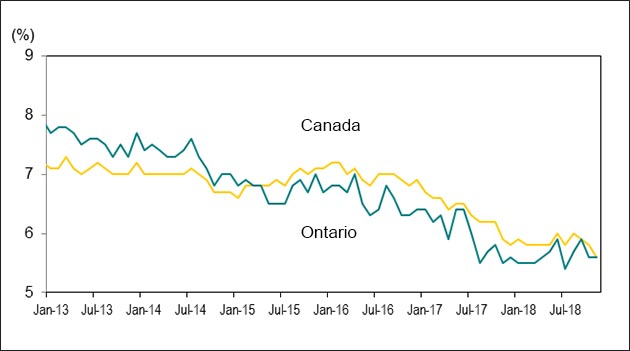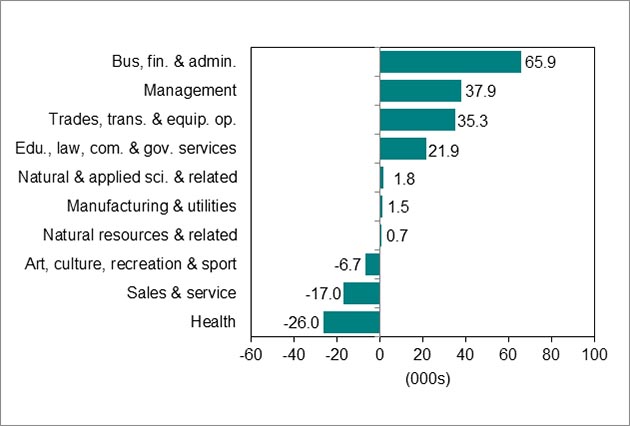Labour market report, November 2018
Employment in Ontario increased in November. Get the details in this report.
Quick facts
In November 2018:
- There were 12.0 million people in Ontario aged 15 years or older
- 7.7 million (64%) were either working or actively looking for work
- 7.3 million (61%) were employed and 82% of them had a full-time job
- Ontario’s unemployment rate was 5.6% (429,700 unemployed people)
Employment increased in November
Employment in Ontario increased in November (20,200), following little change in October.
Chart 1 shows employment in Ontario from January 2013 to November 2018.

Source: Statistics Canada, Labour Force Survey, Table 14-10-0019-01, (seasonally adjusted data).
Full-time vs. part-time
Full-time jobs increased (29,000), while part-time employment declined (8,900).
So far in 2018, full-time employment is up by 133,600 compared to the same period in 2017. Part-time employment is lower (18,200).
Employment increase/decrease by age
Youth employment (those aged 15 to 24) increased by 3,800 in November, after declining by 31,800 in October.
Employment for people aged 25 to 54 increased by 4,600 in November compared to October and those aged 55 and older gained 11,700 jobs.
Employment in Canada increased by 94,100 in November, the largest increase on record. The increase was led by full-time jobs (89,900) and distributed across a range of industries, including health care and social assistance, construction, and business, building and other support services.
Unemployment rate remained at 5.6%
Chart 2 shows unemployment rates, Ontario and Canada, January 2013 to November 2018.

Source: Statistics Canada, Labour Force Survey, Table 14-10-0019-01, (seasonally adjusted data).
Ontario’s unemployment rate remained at 5.6% in November compared to October and has remained below 6.0% since August 2017.
Canada’s unemployment rate was 5.6% in November and the lowest rate on record, down from 5.8% in October.
Unemployment rate by age
For people aged 15 to 24, the unemployment rate in November was unchanged at 12.2% for the third consecutive month.
The unemployment rates for people aged 25 to 54 declined to 4.6% in November from 4.8% in October and increased to 4.2% from 3.7% for those aged 55 and older.
Lowest and highest unemployment rates
Chart 3 shows Census Metropolitan Areas (CMAs) with highest and lowest unemployment rates in Canada, November 2018.

Source: Statistics Canada, Labour Force Survey, Table 14-10-0294-01, (seasonally adjusted data three-month moving average to reduce volatility caused by small sample size).
Brantford and St. Catharines-Niagara were tied for the highest unemployment rate in Ontario (7.0%) in November, while St. John’s, Newfoundland recorded the highest unemployment rate in Canada (8.1%).
Guelph recorded the lowest unemployment rate in Canada in November (3.0%).
Year-over-year comparisons
Over the first eleven months of 2018, employment in Ontario increased by 105,400 net jobs for adults 25 years and older compared to the first eleven months of 2017.
Employment increase and decrease by education level
Chart 4 shows Ontario employment change by highest level of education attained, aged 25 and older, November 2017 to November 2018, year-to-date.

Source: Statistics Canada, Labour Force Survey, Table 14-10-0019-01, unadjusted data
Adults with a university degree led gains with 100,100 net new jobs.
Individuals with some postsecondary education recorded job gains of 26,400, while employment for those with certificates or diplomas increased by 58,100.
People with less than high school education recorded job losses of 26,500 and those with high school education recorded job losses of 52,700.
Unemployment rate by education level
The unemployment rate for adults aged 25 and older with postsecondary education credentials was 4.2% over the first eleven months of 2018, down from 4.4% a year earlier.
The unemployment rate for adults without postsecondary education credentials was 5.7%, down from 6.4% compared to the first eleven months of 2017.
Employment increase and decrease by occupation
Chart 5 shows Ontario employment change by occupation, November 2017 to November 2018, year-to-date.

Source: Statistics Canada, Labour Force Survey, Table 14-10-0296-01, unadjusted data.
Seven of the ten major occupational groups in Ontario had net employment gains over the first eleven months of 2018 compared to a year earlier.
Learn more about the National Occupation Classification (NOC) system.
These occupations gained the most jobs:
- business, finance and administration (65,900)
- management (37,900)
- trades, transport and equipment operators and related (35,300)
These occupations lost jobs:
- health (26,000)
- sales and service (17,000)
- art, culture, recreation and sport (6,700)
Long-term unemployment decreased
Chart 6 shows Ontario’s long-term unemployed (27 weeks or more) as a percentage of total unemployment, November 2010 to November 2018, year-to-date.

Source: Statistics Canada, Labour Force Survey, Table 14-10-0056-01, unadjusted data.
Over the first eleven months of 2018, an average of 73,600 people were long-term unemployed, or unemployed for 27 weeks or longer. This was down from 87,900 a year earlier.
Long-term unemployed individuals accounted for 16.8% of the total number of unemployed people over the first eleven months of 2018. This compared with 19.2% a year earlier.
The percentage of long-term unemployed individuals is still higher compared with the pre-recession level in November 2008, when 13.7% of all unemployed people were long-term unemployed.
Average time in long-term unemployment
The average time in unemployment decreased to 17.2 weeks over the first eleven months of 2018 from 19.2 weeks a year earlier.
Download data
Source: Statistics Canada, Labour Force Survey
November 2018 Labour Market Report:
- CSV, Chart 1, employment in Ontario from January 2013 to November 2018, 1Kb
- CSV, Chart 2 unemployment rates, Ontario and Canada, January 2013 to November 2018, 2Kb
- CSV, Chart 3 Census Metropolitan Areas (CMAs) highest and lowest unemployment rates, 2Kb
- CSV, Chart 4, Ontario employment change by highest level of education, aged 25 and older, 99Kb
- CSV, Chart 5, Ontario employment change by occupation 12Kb
- CSV, Chart 6, Ontario’s long-term unemployed, 15Kb